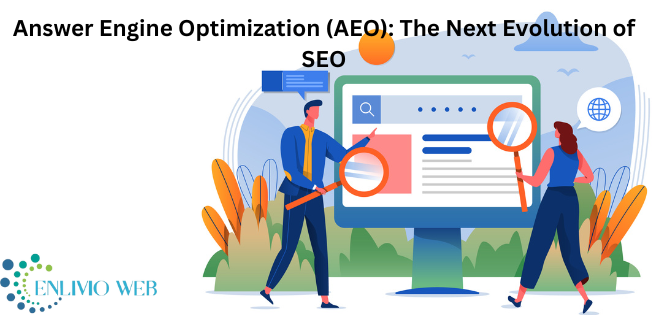In the ever-evolving world of digital marketing, keeping up with new trends in search technology is critical for businesses. While SEO (Search Engine Optimization) has been the cornerstone of online visibility, a new approach called AEO (Answer Engine Optimization) is emerging. This method focuses on providing clear and concise answers to user queries, especially for voice searches and featured snippets on Google.

In this article, we’ll explore AEO, how it differs from traditional SEO, and why optimizing for answers is becoming essential in today’s search engine landscape.
What is AEO?
AEO, or Answer Engine Optimization, involves tailoring content so that it directly addresses user queries in a quick and concise way. Instead of focusing solely on boosting rankings in traditional search results, AEO aims to position content for voice search and Google’s featured snippets, often referred to as position zero.
With the rise of smart assistants like Siri, Google Assistant, and Alexa, more users are searching through voice commands, expecting immediate, accurate responses. AEO is designed to meet these needs by structuring content that delivers quick, direct answers, often without the need for a user to click through multiple links.
How AEO Differs from SEO
Though AEO and SEO share common ground, their focus and implementation are distinct.
- User Intent:
- SEO caters to various user intents, such as browsing for information, purchasing products, or finding specific websites.
- AEO is specifically aimed at answering direct questions, providing quick, factual information in response to a query.
- Content Format:
- Traditional SEO relies on optimizing text, images, and multimedia to boost rankings.
- AEO requires content to be structured in a format suitable for featured snippets or voice responses—typically using brief paragraphs, bullet points, or lists.
- Objective:
- SEO aims to drive traffic to a website by improving its visibility in search results.
- AEO focuses on satisfying the query instantly by providing the exact answer in search results or via voice assistants, without necessarily drawing users to a website.
Why AEO Matters in Today’s Search Landscape
- Growth of Voice Search: With voice search now accounting for a significant portion of search queries, optimizing for natural, conversational language is critical. Over half of all searches are now voice-based, and these users expect fast, precise responses.
- Increased Importance of Featured Snippets: Featured snippets, also known as “position zero,” are prime spots in Google search results where concise answers appear. AEO is designed to help businesses secure these top spots by crafting content that answers popular queries directly.
- Mobile-First Search Experience: As mobile search continues to grow, users are looking for quick answers while on the go. AEO helps provide this information without requiring them to browse through long articles or multiple pages.
How to Implement AEO on Your Website
If you’re looking to take advantage of AEO, here’s how you can get started:
- Research Common Questions: Begin by identifying the questions your audience is most likely to ask. Use tools like AnswerThePublic, Google’s Keyword Planner, or Quora to find out what people are searching for in your industry.
- Create Conversational Content: Voice search queries are usually conversational. Optimize your content to reflect this by incorporating natural, spoken language. For example, rather than targeting “SEO strategies,” structure your content to answer questions like, “What are the best SEO strategies for 2024?”
- Leverage Structured Data (Schema Markup): Implementing structured data helps search engines understand the content on your site. This increases the likelihood of your information being featured in a snippet or used in a voice search response.
- Provide Direct, Clear Answers: Your content should provide direct answers in a format that is easy for search engines to pick up. Break complex information into bite-sized, digestible chunks using lists, headings, and FAQs.
- Optimize for Local Searches: Many voice searches are local in nature (e.g., “Where is the nearest coffee shop?”). Be sure to update your business information and utilize local SEO practices such as Google My Business to capture these searches.
The Future of AEO
As search engines grow smarter, and voice searches become more prevalent, the boundary between SEO and AEO will blur. However, by focusing on AEO strategies now, businesses can stay ahead of the curve and adapt to this shift in how people search.
Voice search and mobile-first indexing are becoming more prominent, and being the first to provide a relevant answer will be a significant competitive advantage. Content that’s optimized for AEO not only increases visibility but ensures that your business can meet the demands of today’s fast-paced, question-driven search environment.
Conclusion
AEO isn’t meant to replace SEO—it’s a crucial extension of it. While traditional SEO is about driving traffic, AEO is about providing immediate value by answering users’ questions in a direct and concise manner.
As voice search continues to grow and search engine algorithms evolve, optimizing for AEO will help ensure that your content remains accessible, relevant, and positioned to capture valuable traffic in the form of answers.


